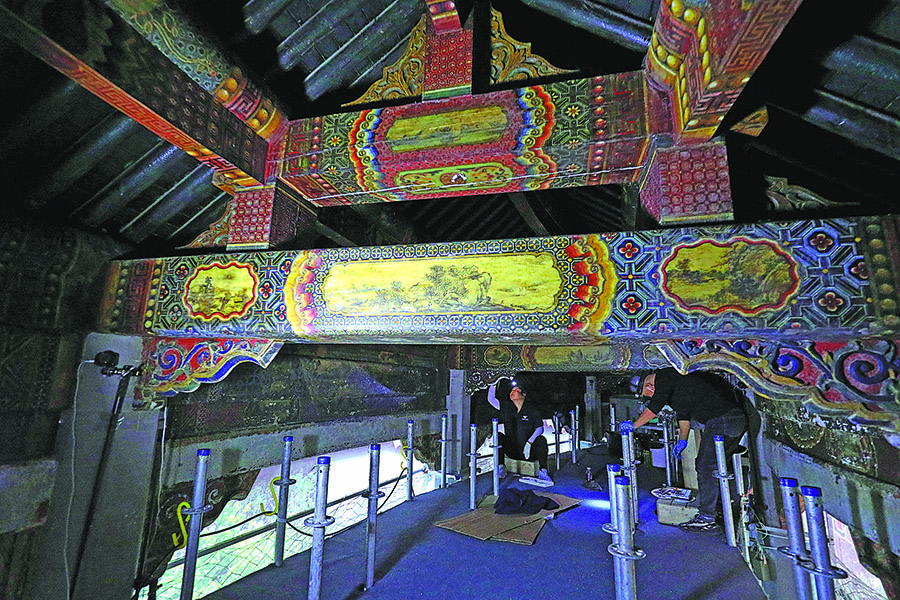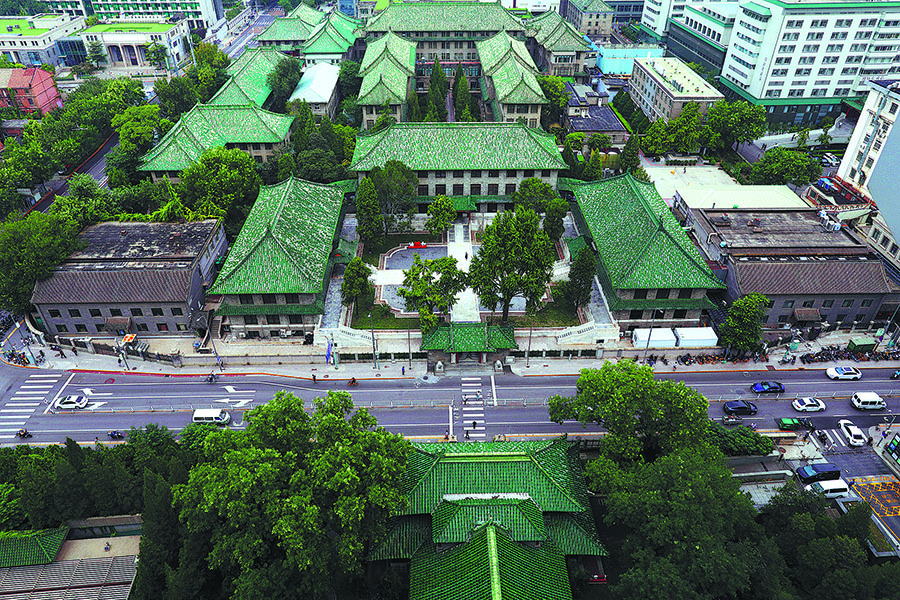Revitalized arcades give college a degree of style
From:China DailyAuthor: 2024-12-02 10:35

Arcades are adorned with colorful paintings, thanks to a restoration project in the school.[PHOTO BYZHU XINGXIN/CHINA DAILY]
After a three-year restoration, the arcades of the Chinese Academy of Medical Sciences and Peking Union Medical College in Beijing have been revitalized, once again showcasing the vibrant colors of the early 20th-century artwork adorning their eaves.
The structure comprises two curved arcades connecting the buildings in the medical college, serving as a vital component of the architectural heritage of the institution. The colorful patterns exhibit a blend of simplicity and elegance, with smooth and gentle lines merging traditional Chinese decorative motifs with Western floral designs.
"It embodies the essence of modern medicine, encompassing both scientific and humanistic elements. The arcades reflect the humanistic connotations and taste within the architecture of the school," Wang Chen, president of the Chinese Academy of Medical Sciences and Peking Union Medical College, said at the restoration launch ceremony early this year.
"The arcades not only showcase the form of Chinese architecture, but also symbolize the integration of disciplines and the collaboration within the medical school."
The restoration project is supported by the National Cultural Heritage Administration and the Beijing Municipal Cultural Heritage Bureau with special funds allocated.
Previously repurposed as office space with added ceilings, the school carried out a comprehensive restoration in 2021. During the removal of side walls from the gatehouses and the two arcades, remnants of the colorful paintings more than 100 years old were uncovered and identified.

An aerial view of the Chinese Academy of Medical Sciences and Peking Union Medical College in Beijing.[PHOTO BYZHU XINGXIN/CHINA DAILY]
According to experts, the paintings were created in the early 20th century with intrinsic cultural and art value. Li Liusan, Party secretary of the China Academy of Cultural Heritage, who guided aspects of the restoration, says that the arcades exemplify the fusion of Eastern and Western art.
He adds the restoration team utilized modern technology to preserve their historical authenticity and aesthetic integrity to the fullest extent.
Gao Feng, head of the restoration team, who is also an expert in mural restoration of the China Academy of Cultural Heritage, says the conservation and restoration plan was complicated and included 53 steps.
The steps included stabilization, repair, surface cleaning, and pigment reconversion. Emerging technologies, such as multispectral and hyperspectral imaging, were also applied in the project.
One of the challenges that Gao's team faced was peeling.
Conservators patiently steamed these areas to soften them and ensure the applied paint could attach itself to the surface.
It was estimated that the restoration of every 0.11 square meters of such areas took about a week to complete.
Gold leaf was originally used in the paintings, and restorers had to follow time-honored methods to apply it in order to preserve their historical authenticity, Gao says.

A relic restorer works on a painting on an arcade. [PHOTO BYZHU XINGXIN/CHINA DAILY]
Reflecting on the restoration project, Gao Le, the project leader at the medical college, recognizes both the difficulty of the task and the significance of the artworks to the school.
"The initial unveiling of these artworks left a profound visual influence and emotional resonance among our team members. There is no doubt that we must prevent further deterioration of these precious artifacts," Gao Le says.
Seeing the restored arcades, Qiu Guixing, a 1968 alumnus of the medical college, recalls his first impression of the school.
"I entered Peking Union Medical College in 1960. I still have my admission letter — it's a beautiful piece. The aesthetics of that time were remarkable, as reflected in these artworks. The college — the birthplace of modern medicine and life sciences in China — is renowned for its unique blend of Eastern and Western architectural artistry," says the 82-year-old orthopedics specialist.
"The paintings are artistic treasures," he adds.
Founded in 1917, Peking Union Medical College is the birthplace of the country's eight-year medical degree course, higher nursing education and public health education.
It has nurtured a large number of distinguished medical experts over the past century, including Lin Qiaozhi (1901-83), who revolutionized modern Chinese gynecology and oncology, Huang Jiasi (1906-84), who pioneered thoracic surgery in the country, and urologist Wu Jieping (1917-2011).
Edit:孙俪洋
The copyright of the article and the picture belongs to the original author. If there is any infringement, please contact to delete it